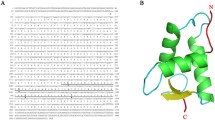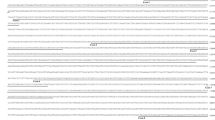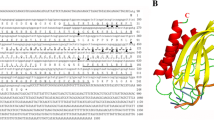Abstract
Transcription of the rat gene encoding haptoglobin (Hp) is highly induced during acute phase (AP) response which has been previously shown to be mediated by inducible STAT3 member of the Signal Transducer and Activators of Transcription (STATs) family proteins. In this study, we observed that under normal but not in the turpentine induced AP conditions, another member of the STAT family proteins, STAT5b is expressed and binds to the hormone regulatory element (HRE) of the rat Hp gene. We found that the nuclear amounts of constitutively active STAT5b in rat liver decreased significantly with time of turpentine treatment as opposed to that of cytosol STAT5b, suggesting possible export of constitutive STAT5b from the nucleus. Nuclear accumulation and binding of inducible STAT3 proteins to the rat Hp gene HRE following turpentine treatment implicated that STAT5b negatively regulates Hp gene expression during normal conditions.
Similar content being viewed by others
References
Ihle JN (1995) Nature 377: 591–594
Ihle JN (1996) Cell 84: 331–334
O_Shea (1997) Immunity 7: 1–11
Darnell JE Jr (1997) Science 277: 1630–1635
Darnell JE Jr, Kerr IM & Stark GR (1994) Science 264: 1415–1421
Ripperger J, Fritz S, Richter K, Hocke GM, Lottspeich F & Fey GH (1995) J. Biol. Chem. 270: 29998–30006
Grigorov I, Lazić T, Cvetković I, Milosavljević T & Petrović M (2000) Mol. Biol. Rep. 27: 81–86
Kushner I & Mackiewicz A (1993) In: Mackiewicz A, Kushner I & Baumann H, (eds), Acute Phase Proteins: Molecular Biology, Biochemistry, and Clinical Applications (pp. 4–14) CRC Press, Inc., Boca Raton, Fl
Baumann H & Gauldie J (1994) Immunol. Today 15: 74–80
Mackiewicz A (1997) Int. Rev. Cytol. 170: 225–300
Baumann H, Prowse KR, Marinković S, Won KA & Jahreis GP (1989) Ann. New York Acad. Sci. 557: 280–295
Marinković S, Jahreis GP, Wong G & Baumann H. (1989) J Immunol.142: 808–812
Ševaljević Lj, Glibetić M, Poznanović G, Petrović M, Matić S & Pantelić D (1988) Burns 14: 280–286
Gorski K, Carneiro M & Schibler U (1986) Cell 47: 767–776
Sambrook J, Fritch EF & Maniatis T (1989) In: Irwin N (Ed.) Molecular Cloning. A Laboratory Manual, Cold Spring Harbor Laboratory Press, Cold Spring Harbor.
Kadonaga JT & Tjian R (1986) Proc. Natl. Acad. Sci. USA 83: 5889–5893.
Ševaljević Lj, Marinković-Pajović S, Grigorov I, Bogojević D, Ivanović-Matić S & Petrović M (1995) Int. J. Biochem. 27: 185–194
Herrington J, Rui L, Luo G, Yu-Lee L & Carter-Su C (1999) J. Biol. Chem. 274: 5138–5145
Ram PA, Park SH, Choi HK & Waxman DJ (1996) J. Biol. Chem. 271: 5929–5940
Ali S & Ali S (1998) J. Biol. Chem. 273: 7709–7716
Milocco LH, Haslam JA, Rosen J & Seidel HM (1999) Mol. Cell. Biol. 19: 2913–2920
Cella N, Groner B & Hynes NE (1998) Mol. Cell. Biol. 18: 1783–1792
Lobie PE, Wood TJ, Chen CM, Waters MJ & Norstedt G (1994) J. Biol. Chem. 269: 31735–31746
Ram PA & Waxman DJ (1997) J. Biol. Chem. 272: 17694–17702
Sackey FN, Hache RJ, Reich T, Kwast-Welfeld J & Waterman ML (1996) Mol. Endocrinol. 10: 1191–1205
Prieve MG, Guttridge KL, Munguia JE & Waterman ML (1996) J. Biol. Chem. 271: 7654–7658
Kim H & Baumann H (1997) J. Biol. Chem. 272: 14571–14579
Horvath CM, Wen Z & Darnell JE, Jr (1995) Genes Dev. 9: 984–994
Runge DM, Runge D, Foth H, Strom SC & Michalopoulos GK (1999) Biochem. Biophys. Res. Commun. 265: 376–381
Author information
Authors and Affiliations
Rights and permissions
About this article
Cite this article
Grigorov, I., Lazić, T., Cvetković, I. et al. Opposite nuclear level and binding activity of STAT5B and STAT3 proteins with rat haptoglobin gene under normal and turpentine induced acute phase conditions. Mol Biol Rep 28, 217–222 (2001). https://doi.org/10.1023/A:1015749109119
Issue Date:
DOI: https://doi.org/10.1023/A:1015749109119




